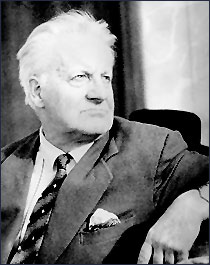 |
|
About [Glasgow Art Club: article by Emilio Coia. 1973]That McGlashan is a ‘natural’ all of Scotland has known for more than half a century. And very probably the Club (this Glasgow Art Club, of which he has been a member for thirty-one years and a trustee) appreciates the fact more than any other group of people or individual anywhere. Which is as it should be: a Club with a celebrated art history and an influential background (Glasgow can thank us for the Whistler portrait of Carlyle) such as we have could scarcely survive if it did not display a close knowledge of, and encourage interest in, it membership – particularly with regard to those who distinguish themselves in their chosen pursuits. Corny though the expression may be, Archibald McGlashan is a kind of living legend - his name and numerous painting activities and anecdotes having been with us literally for all our days. So warmly is he regarded both as an artist and as a man who is temperamentally incapable of malice or envy that even when, on occasion, he produces work which is patently inferior to his best (where is the artist who is never below standard?) criticism is invariably and noticeably withheld – something that is, I think, unique in this geographical situation. Nothing it seems is allowed to tarnish his firmly established reputation, either as a painter or intermediate loquacious companion within these hallowed premises. Archibald McGlashan is eighty-five years of age; it is fitting the Club should accord him this appraisement just now as it would be over optimistic to anticipate many more fresh canvases from his studio. He was born in Paisley and studied at Glasgow School of Art, gaining the Haldane Scholarship in 1912. His principle teacher was Maurice Greiffenhagen who, with Fra H. Newbery, will always be associated with Mackintosh’s masterpiece. Archie visited Spain and Italy and, according to the late Dr. T. J. Honeyman, “in 1913 he spent six months in Madrid copying Velasquez, El Greco and Titian. He became aware of how much Spain owed to Italy. This discovery compelled him to continue his studies of the great Italian painters in their own country…” Tom Honeyman, who did so much - with the willing assistance of the late A.J.McNeill Reid - to introduce Archie to London, goes on to remark that….”He (Archie) has told me that he understood the French ‘moderns’, although he never attempted to paint like them, as was the custom among most of his contemporaries. This was not because he adopted a detached or superior point of view. He was well aware of the fact that the theory and practice of French art from Impressionism onwards has become fused with the general trends of European painting. But a disciple need not be a slave…” Archie’s independence of outlook linked him with other naturally rebellious painters like Robert Sivell and James Cowie, and elsewhere Honeyman recalls the “mild furore in Glasgow art circles when in the late twenties the Royal Glasgow Institute of the Fine Arts rejected two paintings, one by Sivell and the other by McGlashan.”. (Big mixed shows, it may be remarked in passing, are by their very constitution prone to committing judgements that rebound to their eternal discredit: from off the top of one’s head one recalls the Royal Academy’s rejection of Wyndham Lewis’s portrait of T.S. Eliot – which caused Augustus John’s resignation from that august body – and the Glasgow Institute’s comparatively recent rejection of several Joan Eardley pastels, subsequently rescued and hung by, I think, William Armour). It is undeniable that Homeyman played a prominent part in establishing Archie’s reputation in and out of London by obtaining for him commissions to paint the children of well-known public figures, including several connected with the theatre, and it is not surprising that he soon won the support of that consistent patron of arts, Sir Edward Marsh, who is perhaps more renowned as a friend of Rupert Brooke. Among his admirers Archie could include Duncan Grant and Ethel Walker, both of whom were generous in their praise. But on the whole McGlashan story must be reserved for more able and knowledgeable hands; for this immediate purpose suffice it to say that he married the benevolent, enchanting Teresa Giuliani (she died in 1971) who had her roots in Lucca and whose brother was the well-known Dr. Giuliani of Glasgow; that Archie was a member of the Glasgow Society of Painters and Sculptors which was formed shortly after the end of the first World war; that he was made an associate member of the R.S.A in 1935 and admitted full membership in 1939; that he has two daughters and one son – Angela (Mrs. Wylie), Agnes (Mrs. Gillies) and John who is a brilliant and well-established freelance cartoonist in London. Archie has served as a Governor of the School of Art, but no university has yet recognised his contribution to Scottish painting. Emilio Coia |
